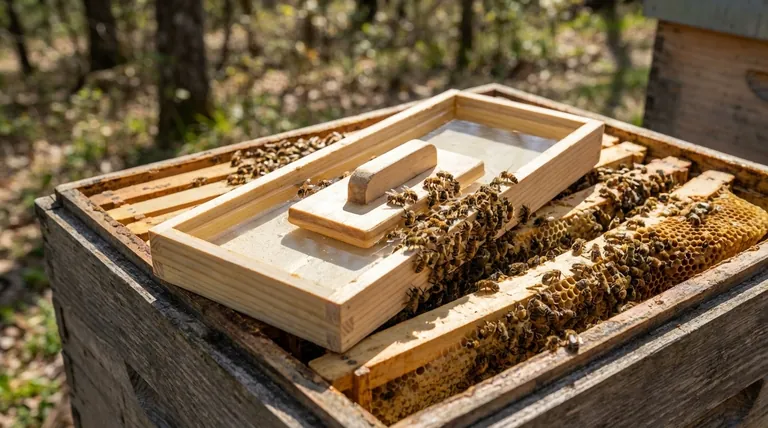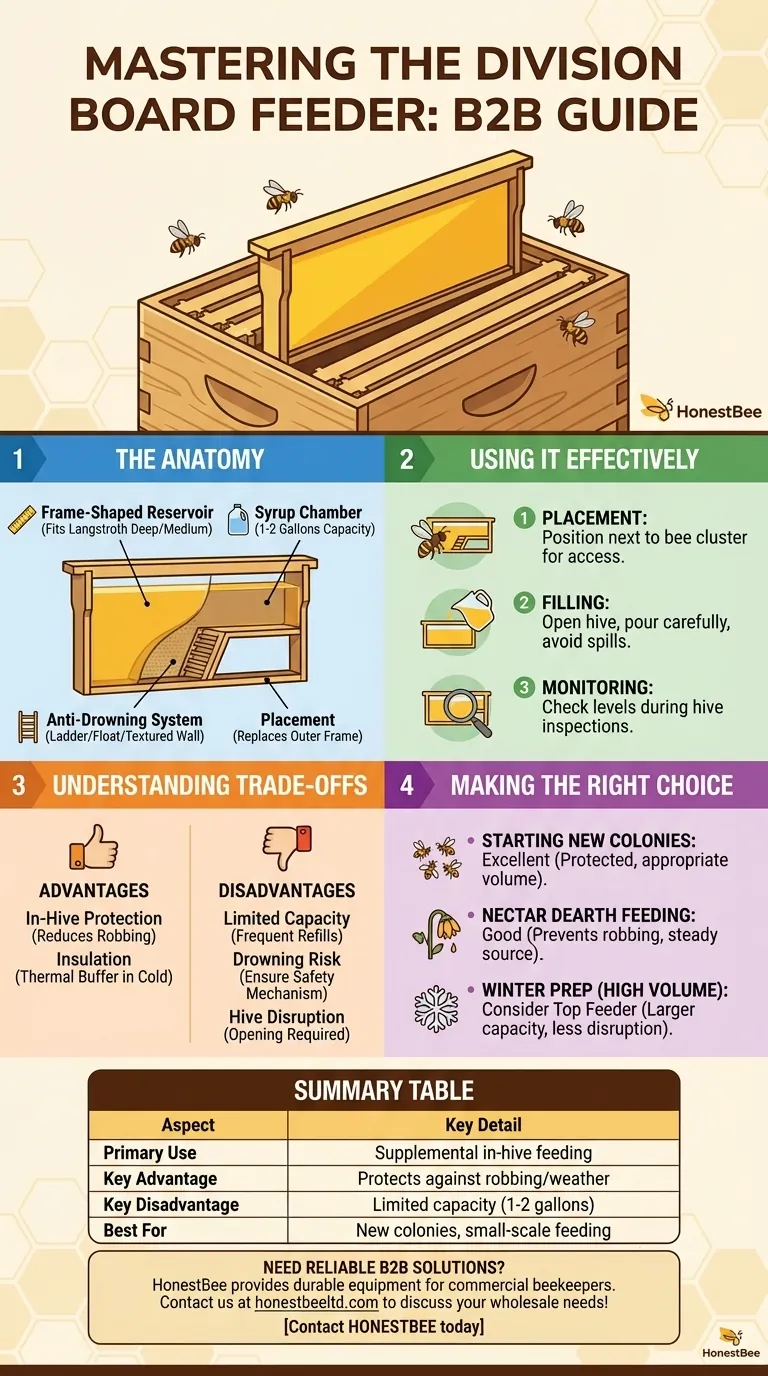A division board feeder is an in-hive container designed to hold sugar syrup, shaped like a standard hive frame. This allows it to be placed directly inside the hive body alongside the brood frames, providing a convenient and protected food source for the bees. Its primary purpose is to deliver supplemental nutrition without exposing the syrup to outside raiders or the elements.
The division board feeder is a tool of convenience and protection. While it offers excellent in-hive security against robbing, its effectiveness hinges on understanding its limited capacity and managing the inherent risk of bees drowning.

The Anatomy of a Division Board Feeder
A division board feeder, also known as a frame feeder, is simple in design but serves a critical function. Understanding its components is key to using it safely and effectively.
The Frame-Shaped Reservoir
The main body of the feeder is a plastic or wooden container molded to the exact dimensions of a Langstroth deep or medium frame. This allows it to take the place of one or two frames within the hive box, integrating seamlessly into the colony's living space.
The Syrup Chamber
This internal reservoir typically holds between one and two gallons of sugar syrup. Its placement inside the hive helps keep the syrup warm, making it easier for the bees to consume, especially in cooler weather.
The Anti-Drowning System
This is the most critical safety feature. Because bees can easily drown in open liquid, the feeder includes a mechanism for them to safely access the syrup. This often consists of a plastic ladder, a wooden float, or a textured inner wall that allows bees to climb down to the liquid and back up again without falling in.
Using a Division Board Feeder Effectively
Proper use minimizes stress on the colony and maximizes the benefit of the supplemental feed. The process is straightforward but requires care.
Placement and Installation
The feeder is typically placed toward the outside of the hive box, replacing an outer frame. For a new or small colony, placing it right next to the cluster of bees makes the food source easily accessible.
Filling the Feeder
To fill the feeder, you must open the hive. Mix your sugar syrup beforehand and use a pitcher or funnel to pour it carefully into the reservoir. Avoid splashing or spilling syrup, as this can incite robbing from other nearby bee colonies.
Monitoring Consumption
Since you must open the hive to check the syrup level, you will be inspecting the colony at the same time. This allows you to monitor how quickly the bees are consuming the feed and adjust your refilling schedule accordingly.
Understanding the Trade-offs
No single piece of beekeeping equipment is perfect for every situation. The division board feeder has clear advantages and disadvantages that you must weigh.
Advantage: In-Hive Protection
By containing the syrup entirely within the hive, the feeder drastically reduces the risk of robbing. Open-air feeders can attract bees, wasps, and other insects from a wide area, creating chaos and potentially leading to the destruction of a weaker colony.
Advantage: Insulation
A full feeder can act as a thermal buffer, similar to a frame of honey. In cooler climates, it can help the colony maintain a stable internal temperature, functioning as an insulated "wall" on the edge of the brood nest.
Disadvantage: Limited Capacity
Most frame feeders hold one to two gallons. For major feeding events, such as preparing a colony for winter, this small capacity requires frequent refills, which means repeatedly disturbing the hive. In these cases, larger-volume top feeders are often a better choice.
Disadvantage: Drowning Risk
If the feeder's float or ladder system is poorly designed, breaks, or is not used, a large number of bees can become trapped and drown. Always ensure the anti-drowning mechanism is in place and functioning correctly before filling.
Disadvantage: Hive Disruption
Refilling a division board feeder requires you to open the hive, break the propolis seal, and expose the colony to the elements. While this is often combined with a regular inspection, it is still a disruptive event for the bees.
Making the Right Choice for Your Goal
Selecting a feeder depends entirely on your specific objective for the colony at a given time.
- If your primary focus is starting a new, small colony: The division board feeder is an excellent choice due to its protected, in-hive location and appropriate volume.
- If your primary focus is supplemental feeding during a nectar dearth: This feeder works well to prevent robbing while providing a steady food source.
- If your primary focus is rapid, high-volume feeding for winter preparation: Consider a top feeder, as its larger capacity will require you to disturb the bees less frequently.
Ultimately, understanding the design of a division board feeder empowers you to use it as an effective tool for targeted colony support.
Summary Table:
| Aspect | Key Detail |
|---|---|
| Primary Use | Supplemental feeding inside the hive |
| Key Advantage | Protects against robbing and weather |
| Key Disadvantage | Limited capacity (1-2 gallons) |
| Best For | New colonies, small-scale feeding |
Need reliable feeding solutions for your apiary? HONESTBEE supplies commercial beekeepers and distributors with durable, well-designed beekeeping equipment, including feeders that minimize drowning risks. Let our wholesale-focused expertise help you choose the right tools for your operation. Contact HONESTBEE today to discuss your needs!
Visual Guide

Related Products
- Classic Boardman Entrance Bee Feeder Hive Front Feeding Solution
- Boardman Entrance Bee Feeder Durable Galvanized Steel and Wood Construction for Beekeeping
- Professional Hive Front Entrance Bee Feeder
- HONESTBEE Entrance Bee Feeder Efficient Hive Front Liquid Feeding Solution for Beekeeping
- In-Hive Dual Compartment Frame Bee Feeder for Targeted Colony Nutrition
People Also Ask
- How to make an entrance feeder for bees? A DIY Guide for Safe & Effective Feeding
- What are the different types of honey bee feeders? Choose the Right Feeder for Your Hive
- How do you make an entrance feeder for bees? A Guide to Safe & Effective Hive Feeding
- What is a common problem with hive front feeders? Avoid Robbing Frenzies and Protect Your Hives
- How can a Boardman Feeder be used to provide water to bees? Avoid These Critical Risks to Your Hive



















